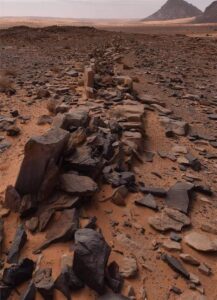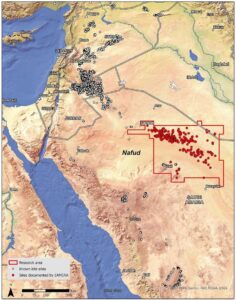The Department of Treasures, Burials and Antiquities of the Arab world has issued an update regarding the discovery of large desert traps in different structures and shapes in the deserts of Saudi Arabia, which are more than 7000 years old.
The findings were unveiled in the northern part of the Kingdom and are considered the world’s oldest traps dating back to prehistoric times.
According to the excavation team, the traps include the shapes of kites, stone and fishing structures which have been observed through the satellite images recently gathered in the region of Northern Saudi Arabia and Southern Iraq. In addition, “These structures are called ‘paper planes’ and reveal micro-fishing practices dating back 8,000 years,” said the experts.

The reports also stated that the strange structures stretch for kilometres and cover a large area of the desert. The scientific team further noted that “The date of “kite” fishing structures dates back nearly 8,000 years and demonstrates highly sophisticated fishing techniques. These installations were used during the modern Stone Age.”
“The traps worked in a mechanism and consisted of low stone walls that form paths in which humans guide prey to fall into idolatry; they then found themselves in a central fence, the “head” of the kite plane, to be killed. Cells were also found hidden in the walls, which could also serve as an entrapment hole,” added the scientist team.

While extending the additional explanation for the traps discovered in Saudi Arabia, the team of scientists conveyed that the discovery is a significant success in unveiling the prehistoric ways of trapping prey.
Moreover, the Heritage Board clarified that the results of the team’s work confirmed that the northern areas of Saudi Arabia experienced civil development about 5,000 years ago BC. M. With the evidence of building a huge potential. It included hundreds of large stone structures, and it was an important cultural change and civilizational transformation in the area.
It was pointed out that this scientific work, published by the results of the International Scientific Journal of Holusin, specialized in prehistoric studies, is among the field works of the Green Arab Island Project.
The Heritage Board led the project with the participation of the German Max Blanc Institute, Oxford University, and King Saud University, said reports.

The scientific fieldwork carried out by the team covers the beginnings of the development of stone structures within their archaeological and environmental context, especially rectangles, which were described as animal traps.
These rectangles played a similar role and reflected the development of the regional behaviour of humans by competing on pastures in difficult and unstable environments in Arabian Island until, in the wet times of the Holocene era, the environment was going through periods of drought.

Additionally, it was also said that the current work for the Arabian Green Island Project focuses on the southern outskirts of the Nafud Desert; to study the prehistoric region and its ancient environment in recent decades and the south of the Nafud Desert from the western border of Mount Aja in the Hael region to Taimaa west.
These stone rectangles were checked after analyzing, studying, choosing a number of them and standing on them in Jeba in an area of many seasons, their construction and related cultural materials were scanned and photographed, and an organic sample of coal and shells was raised to date them from one of those rectangles.
So far, 104 stone structures have been identified around the southern embankment of the Nafud Desert, whose number indicates that they are spread away from Khyber Free, and these rectangles are expected to be found east during the study, and stone rectangles south of Khyber Free.

The results of the study showed that these stone rectangles that spread across the southern part of the Nafud Desert look evenly and conclusive. Still, they are in the form of a whole, most of them formed in the form of rectangles that are close to each other and gathered in groups, distributed evenly on the outskirts of the southern Nafud.
As three-quarters of these stone rectangles are erected on hills or portals, most of them are erected around ancient lakes or swamps, while some rectangles were erected on the plains and around the banks of the lakes.
Whereas some rectangles are established away from water sources at a distance of about six-axis, and the average distance from the nearest lakes is six-axis, some are within a kilometre distance from essential water sources, including water tables.
In terms of the sizes, shapes and structure of stone rectangles, the study has clarified the coexistence of rectangular shapes in the southern desert of the Nafud, where they seem long, and their sides are mostly less than half a meter high.
“Most of the rectangles appear in large sizes; some of them are more than 600 meters long, 10 meters wide and 1 meter high. The rectangles are often linked to bull’s eye, earring graves, key entrance graves, and stone circles,” noted the scientist team.
The scientific team found a number of cultural materials on the site, including Fassan: one inside a rectangle and another outside it, and also fragrant quartz fragments close to some structures sharpened from rectangle stones.
As well as a sandstone brushed beside a rectangle and other coloured stones perhaps used for religious rites, please. A diverse number of animal bones are associated with those rectangles.
The relative chronological sequence of rectangles revealed that study results matched with results of previous studies in Saudi Arabia; these institutions were thrown from 5000 to 2000 BC. While the results of history analysis conducted on coal samples showed that it dates to the period (5052 to 4942) BC during the modern Stone Age and others from (2930 to 2770) BC during the Bronze Age, while other samples were thrown from the site from (786 to 666) G. From the Iron Age.
The findings suggest that the rectangles, especially addressed to them, constitute a historical treasure of the prehistoric Arabian Island, likely to have promising results leading to many important developments in human life on earth.
In the end, a comprehensive archaeological survey more than 40 years ago recorded a large number of these stone structures of varying shapes and sizes in different parts of the Kingdom,



